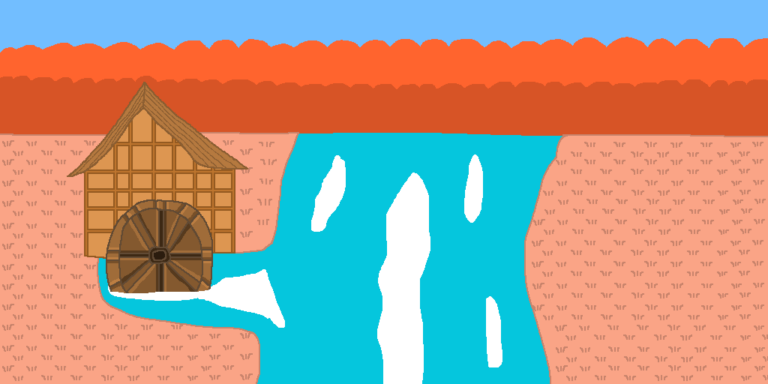Join US
Do you want to build the fantasy world you’ve always dreamed of?
Subscribe to receive notifications when a new post is out and for our monthly newsletter!
You can always unsubscribe anytime.


There’s nothing more quaint than taking a stroll out in the countryside and walking alongside a river, only to come across a watermill. Fantasy watermills are a common feature, appearing in many worlds across the genre like Skyrim and for good reason. They are among the first major sources of power generation, especially in medieval worlds, which enables people to do things they previously couldn’t do.
Watermills are a prominent part of fantasy and have been for a long time. They are the first signs of a medieval society slowly becoming industrialized as people learn how to harness the natural elements and use them in many different ways. Readers associate them with bucolic settings, evoking pleasant memories of a society long past.
The beauty of fantasy watermills is that you can find them in many places. The only requirement is that they be located adjacent to rivers or other streams. This means they appear across a wide diversity of biomes like forests and plains.
Watermills in fantasy operate exactly like their real world counterparts. They have a large waterwheel that constantly moves, generating the power necessary to operate things, and a building where workers use its power for a great number of things. Relying on watermills helps lessen the need to use other sources of power. It’s better to use a diversity of power sources instead of just using one or two.
Fantasy watermills are integral to the world in that the power they generate help people do things that they would have had a harder time doing before. For example, they help logging companies cut more wood efficiently in a shorter span of time. It is for this reason that many manufacturing businesses operate near a river which in turn provides jobs for nearby towns.
This is article number fourteen in the fantasy buildings series. If you can’t get enough of this article and want more, you can find them on our blog page!
Watermills in the genre come in many shapes and sizes but the one common denominator they all have is that they’re located right next to a river or other bodies of flowing water. The reason for this is so that the waterwheel can operate properly. It wouldn’t be a watermill if it didn’t have one, would it?
This means that you can find them wherever there’s a river or stream that provides a good, constant flow of water all year round. Where then do you find rivers? Look at maps of the real world and you’ll see that they appear in many places.
Rivers appear in:

Can you put a watermill in all of these places? Not necessarily. Places like the desert simply won’t work since its arid conditions make it difficult to have a good, continuous flow of water. The tundra and frozen wastelands are not an ideal place because the frozen water makes it impossible for a watermill to function properly.
Many of the other places will work but you also have to account for seasonal fluctuations. During the winter months, rivers are frozen which means the fantasy watermills will be closed, at least until the spring thaw. When they thaw, they generate more power than usual and dry up in the summer due to the heat. Including the seasonal fluctuations in your world helps add a realistic touch and makes it easier for your readers to fully immerse themselves in the world you created.
Since many worlds in fantasy are set in medieval times, watermills become an invaluable source of power for people since they’re considered one of the first signs of industrialization. Learning how to harness the power of water leads people to do things previously out of reach beforehand.
Before the advent of watermills, horses and other animals like the ox were the major power sources people used. They used them to create rows of crops and irrigate them or move heavy things among a myriad of other activities. With the power of watermills, they can do more things though what they can do is confined to the areas adjacent to the river since power lines are far into the future.
It is precisely this reason that many medieval manufacturing companies establish operations right next to rivers. Since they’re the major consumers of power, having a functioning watermill enables them to do more in a smaller amount of time. This is ideal for businesses that focus on logging or textiles that require a constant supply of power to operate.

Manufacturing companies aren’t the only type of business that set up shop on the river. Those dependent on water like the ones in agriculture do the same. Farmers and animal breeders use the power generated by fantasy watermills to increase the amount of crops and animals they grow without having to expend as much energy as they did previously.
While watermills are mostly used in the countryside, they have their fair share of use in town as well. Places like bakeries and forges tap into the power of water to make their products, which in turn they sell to their customers in order to keep their doors open. Watermills appear in many towns and cities, especially the capital.
Using watermills helps reduce people’s dependence on one or two major sources of power which is a good thing. For instance, horses and oxen can only be used from the spring to fall whereas watermills can go all year round, at least in some places. Furthermore, relying on them frees up horses and other animals to do other jobs, leading to both the local and national economies diversifying even more as new commercial frontiers arise.
With how much of an impact they have in their local communities, it shouldn’t come as a surprise that fantasy watermills are vital to the world. Remember, many worlds in the genre take place in medieval times and watermills were popular during these times. Indeed, watermills were an integral component of making the medieval economy work.
Why is this the case? It’s simply because they enabled people and companies to do more using less power. Take logging companies for example. Before watermills were used, people had to physically cut trees down using axes. With them, all they have to do is haul large segments of trees to the cutting floor where a saw powered up by the waterwheel does the cutting for them, saving them time. This lets them focus more on other activities that benefit the companies and the communities they serve.
For bakeries, fantasy watermills are a godsend. They’re able to produce a larger volume of yummy goods that they can sell to their customers, thereby increasing their profit and having more satisfied customers. That is a win-win!

Watermills are part of the backbone of the medieval economy — and those of worlds set in later times as well — and a large part of that economy featured people making things and selling them. Manufacturing companies were a key driver in the burgeoning medieval economy and were the source of many people’s livelihoods. They established operations right on rivers and recruited many of the locals.
Rivers were important to the medieval economy due to them being easily navigable for transporting goods. Located right on them, fantasy watermills generated the power necessary for riverside businesses and communities to do activities such as producing and sending goods to distant places which brought prosperity to these places.
The widespread use of fantasy watermills is the first part of the world industrializing. They show a glimmering glimpse of the world to come which can and will cause upheaval as the world transitions from a medieval economy to one based on industry. At least with watermills, the medieval world still retains its rural-oriented outlook, at least for the time being.
Watermills in fantasy come with many benefits which is precisely the reason why you see them in many worlds across the genre. For the people living in these worlds, they give them the option to do more with less and is a sign that their technological level is progressing. They’re their first source of power that isn’t reliant on other people or animals.
Watermills appear in many parts of the world; whenever there’s a river, there’s a good bet you can stumble across one. Popular places you can find them are forests, mountains, and towns. Just be sure to account for how the change in seasons affect the water level since said level will significantly impact how well the watermills function.
Harnessing the power of these contraptions lets people devote more time to their other priorities since the power their waterwheels generate help reduce the number of tasks they have to do. Using them helps people decrease their reliance on what they’ve been using as power for a long time. Furthermore, watermills help diversify the types of power sources so that people don’t have to just use one or two all the time.
Fantasy watermills are an invaluable part of the medieval economy since many worlds in the genre take place during these times. They help manufacturing companies, farmers, and other people be more efficient using less resources. They are also the very first signs of a society starting to enter a period of industrialization.
Have you given much thought to including them in your world? If not, fantasy watermills can add a splash of realism to yours!
Let me know what you think in the comments below. (Note: this is an account-exclusive feature).
If you don’t have one, you can register here. It only takes a few moments of your time!
Liked this article and want to subscribe? All you have to do is fill out the form below and that’s it!
Thanks for reading this and until the next time,
Sunfire
Subscribing means you receive:
You can always unsubscribe anytime.
Do you want to build the fantasy world you’ve always dreamed of?
Subscribe to receive notifications when a new post is out and for our monthly newsletter!
You can always unsubscribe anytime.